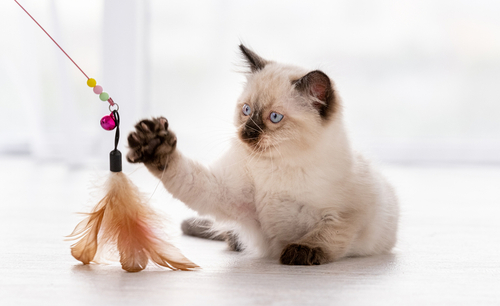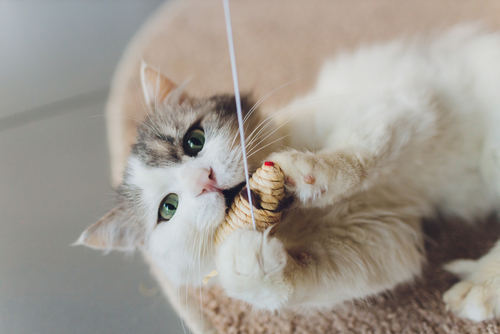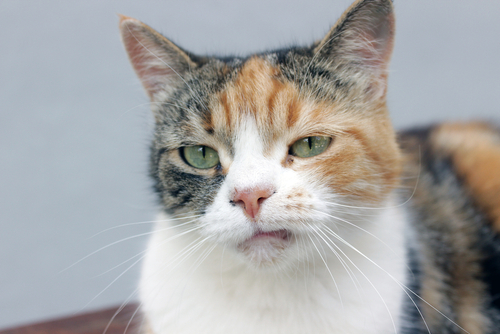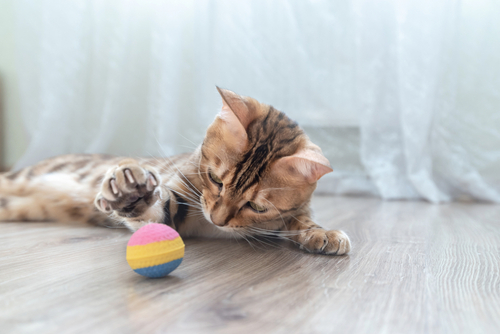Top Tips for Playing With Your Cat
Posted: 08/18/2022 | BY: Erin Cain | Categories: Behavior , Cat , Pet care , Top Tips
If you’re a cat owner, you know that cats love to play. But sometimes, it can be hard to come up with ideas on how to entertain your feline friend. If you’re looking for some new ways to play with your cat, you’ve come to the right place. In this post, we’ll give you our top tips for playing with your cat. Keep reading for more!

Why should I play with my cat?
When owners play regularly with their cats, it strengthens their bond and reduces unwanted feline behaviors, all while promoting a healthy body condition. Playing with your cat makes for a happy and content kitty.
According to feline behavioral specialists, regular play inhibits destructive cat behaviors such as inappropriate scratching, aggression, or spraying. It also reduces stress, often leading to more serious diseases and medical conditions. Playing with your cat may also prevent undesirable habits, such as picking fights with other cats or scratching the sofa, and helps your cat release built-up energy.
Cat parents can maintain a cat’s weight and muscle tone by keeping them active and stimulated. Additionally, playing keeps the cat’s mind active and alert. Cats need mental stimulation as they are intelligent creatures. Keeping them physically and mentally engaged can help them live longer.
Games can help lower stress levels in both cats and humans. While playing can help you recharge, it can also help mellow out a nervous feline. Stressed cats frequently develop urination problems or other health conditions, such as gastrointestinal upset, inappropriate elimination, vomiting, and decreased appetite.
When cat playtime doesn’t provide enough physical activity, cats are more likely to exhibit undesirable behaviors. Regular, active playtimes and an enriched environment can help fix many common cat owner complaints.

How should you play with a cat?
Every cat plays differently — one wants to catch the toy, while another prefers a long chase. Siamese cats are much more active than the Russian Blue, and kittens have different demands than elderly cats.
The following six top tips for playing with your cat will help you make the most of each play session.
1. Use prey toys.
Toys that look like prey should be controlled by the owner and made to look like prey. For example, mice use quick starts and stops. They sometimes stand still out of fear or move in a different direction. Mimic the same behavior with the toy. Scurry it across the floor, so it looks like it’s darting under the couch. Pole-mounted toys, string-pull toys, and soft toys you can drag or toss are all excellent options.
Pet parents should give domestic cats a chance to live as closely as possible to the way their wild counterparts do. Cats are similar to cougars, lynxes, and mountain cats enjoy hiding, climbing, jumping, stalking, chasing, pouncing, trapping, and biting.
2. Use cardboard boxes.
Cats love cardboard boxes and paper bags. Place the toy behind them or under door gaps, rugs, or blankets to make the game more exciting and challenging. Understand that, unlike a dog, your feline friend won’t run nonstop. Cats rarely announce their presence to “prey.” Instead, they prefer a sneakier approach, and they crouch low until they get close enough to attack and then leap.

3. Give multiple cats individual playtime.
Make time to play with each cat individually if you have more than one. You may have one cat intimidate the other if you do not have a toy for each of them. You can play with one cat while the other is in a separate room with a catnip toy and then change.
4. Let your cat “win.”
Allow your cat to triumph. Slow down the actions of the prey toy, as a wounded animal would in the wild. Then, let the cat seize the toy with her front paws and then savage and kick it with her back legs.
Use fewer toys to keep your cat engaged that provide various play methods. Try out different toys with your cat to see which ones they prefer. If you are new to cats, bring a variety of toys to keep them occupied. When you use a laser toy or cat-game app with your cat, finish the game with a toy your cat can catch. Virtual prey games may aggravate some cats if there is nothing for them to actually catch at the end.
5. Establish clear play boundaries.
It’s imperative that you establish clear boundaries with your feline friend. Don’t allow your cat to bite at your hands, fingers, or feet. According to feline logic, if it’s okay to nibble on your toes when you’re sleeping, it must also be acceptable when you’re awake. Establish and stick to rules to avoid confusing your cat.

6. Give your cat breaks when necessary.
If play becomes frantic or furious, keep an eye on your cat’s actions. Take a break if she walks away or if play gets too intense. Each cat has a distinctive personality; some felines get wound up more quickly than others. Adapt the activities to your cat’s abilities and limitations, especially when caring for an elderly cat or raising a kitten.

What should you look for in cat toys?
According to research, a cat’s inclination to play is influenced by the same characteristics that draw them to hunt. Cats are more enthusiastic about toys that look like potential prey, such as bugs, birds, and serpents. For example, a fluffy, feathery creature that leaps and flickers like a real bird will certainly charm your kitten.
However, it is vital to offer your cat alternatives, as cats have their preferences:
- Instead of a feathery toy, give her a ball.
- If she avoids soft toys, try one covered in sisal. You can even experiment with toys with added catnip taste and smell.
- Choose toys made of attractive materials or fabric that combines different textures.
Crinkly materials, fur, fleece, or sisal work well, as do toys that make sounds.
Matching your cat’s personality with a suitable toy is what’s most important. If your cat likes to pick up her toys, get a smaller one she can carry around. If your cat is shy, provide her with a toy she can easily overcome. Alternatively, give her something more challenging if your cat is confident and athletic.
Use food puzzles to entice your cat if she is overweight or doesn’t play much. The puzzles force your cat to work to get the treats out. Catnip toys are another option. Catnip attraction usually occurs when a kitten is six months old. A cat may react to catnip as early as three months old, but a cat rolling around with catnip would be uncommon for a younger kitten. If the cat has been exposed to the plant frequently, he will be less responsive to it.

What if you don’t have cat toys at home?
Cats get bored easily, so novelty is essential. You don’t have to maintain a large inventory of toys or spend a lot of money to have fun with your feline friend. Here are a few suggestions for having fun without toys at home.
Even if you don’t have cat toys on hand, there are plenty of safe household alternatives you can use. Cats are always interested in crinkly, shiny objects (like aluminum foil balls). Wadded-up paper is also effective. Send a ball skidding across the floor and see your cat pursue and bat it.
The reflected light on the carpet, walls, and ceiling is also intriguing. Soon your cat will start chasing and chattering after a pocket mirror if you use one.
Cats love to play with paper bags because of their rustling sound, and you’ll notice that your cat might hide something inside and then jump on the bag to hear it. Cats often utilize paper bags as hideaways, and you can create a paper-bag tunnel for even more enjoyment.
Have fun playing with your cat!
Cats must experience regular mental and physical stimulation to be happy. Pet parents can provide their cats with various mental and physical activities. Games are a fantastic way to allow cats to express their natural behaviors safely. Your cat will stay happy and out of trouble if you safely challenge her senses or make her work for rewards.
A cat health insurance plan is an extra layer of protection.
Cats love to play, and playing with your cat daily is the best way to bond, socialize, and train her. Unfortunately, cats are curious, which can get them into unexpected situations that can harm them.
When an emergency happens with your cat, you will want to know that your cat will receive top care. Pet Insurance Review finds the best pet health care policies to meet your financial needs and your pet’s medical care. Get your cat a free quote today, then get back to playtime!
References:
- Bahner, S. (2022). How to enhance the bond between you and your cat. Retrieved from https://animalwellnessmagazine.com/bond-cat/
- Morris Animal Inn. (2022). 8 Exercise Games for Indoor Cats. Retrieved from https://www.morrisanimalinn.com/blog/8-exercise-games-indoor-cats/
- Countryside Veterinary Clinic. (2022). How to Enrich the Life of Your Indoor Cat. Retrieved from https://www.countrysideveterinaryclinic.org/services/cats/blog/how-enrich-life-your-indoor-cat
- Stella, J., Croney, C., Buffington, T. (2013). Effects of stressors on the behavior and physiology of domestic cats. Retrieved from https://www.ncbi.nlm.nih.gov/pmc/articles/PMC4157662/
- Bedwell Wilson, W. (2021). How to Stop a Cat From Biting You — and Teach Them to Play Nice. Retrieved from https://be.chewy.com/how-to-stop-cat-from-biting/
- Moutinho, S. (2021). Why cats are crazy for catnip. Retrieved from https://www.science.org/content/article/why-cats-are-crazy-catnip
Disclaimer
The information contained on this blog is intended for informational and educational purposes only and should not be construed as medical advice. It is not a substitute for professional veterinary care. Always consult with your veterinarian before making any changes to your pet's health care or treatment plan.
The authors of this blog are not veterinarians and do not claim to be experts in pet health. The information provided here is based on our own experiences and research, as well as information from reputable sources. However, we cannot guarantee the accuracy or completeness of this information.
We encourage you to do your own research and consult with your veterinarian before making any decisions about your pet's health.
Previous post
6 Reasons Why Cats SneezeCompare top pet insurance providers plans.
Enter your dog’s age in years and months to calculate their age equivalent to human years.
Calculate your dog’s ageEnter your cat’s age in years and months to calculate their age equivalent to human years.
Calculate your cat’s age